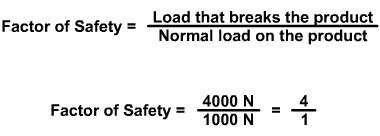IntroductionAll products should be safe to use. In order to be sure that products and structures are safe, even in extraordinary circumstances, they should be built much stronger than they need to be in normal use. This extra strength is called a factor of safety. Structures are tested to make sure that they are safe and that:
The photograph opposite illustrates a swing being used by more children than it was probably intended for. Without a factor of safety being built into the structure, a terrible accident could occur if the swing was not strong enough to bear the load of all the children on it and it would collapse or tip over. For the swing to be really safe, it must be strong enough and stable enough to bear loads far greater than those imposed by the seven little children in the photograph. A factor of safety must be built into the design.
|
 |
Factor of Safety
The Factor of Safety is a number that is worked out by dividing the load that breaks a product, (e.g. the swing in the photograph) by the load that the product is usually expected to bear. In the example of the children's swing, we will say that we require a Factor of Safety of 4, i.e. the swing should be built to withstand loads 4 times greater than those normally imposed by children playing on it.

If we say that children playing on the swing normally impose a load of 1000 Newtons or less, the calculation would look like this:

The swing would have to withstand a load of 4000 Newtons without breaking for it to be considered safe to use in all conditions.